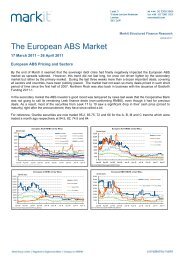The CDS Big Bang Research Report - Markit.com
The CDS Big Bang Research Report - Markit.com
The CDS Big Bang Research Report - Markit.com
Create successful ePaper yourself
Turn your PDF publications into a flip-book with our unique Google optimized e-Paper software.
<strong>CDS</strong> <strong>Big</strong> <strong>Bang</strong>: Contract and Convention Changes<br />
Migration of Old Contracts to New Contracts/Conventions<br />
<strong>Big</strong> <strong>Bang</strong> Protocol<br />
In order to migrate legacy trades to include the hardwiring of the auction mechanism, allow for binding arbitration and<br />
event determination through the determination <strong>com</strong>mittees, and change the effective date for credit and succession<br />
events, there will be a protocol where participants can agree to adhere to these changes in much the same manner as<br />
participants can elect to adhere to the auction protocols today. By agreeing to the protocol, adherents would make the<br />
ISDA Supplement to the 2003 Credit Derivatives Definitions apply retroactively to existing positions. <strong>The</strong> final protocol is<br />
expected to be published on March 12, 2009. Those electing to adhere will have until April 7 th , 2009 to send an<br />
adherence letter to ISDA with changes going in effect the following day. It is important to note that the <strong>Big</strong> <strong>Bang</strong> Protocol<br />
does not address the various coupons of legacy trades nor does it address modifying legacy positions beyond these<br />
provisions.<br />
Portfolio Re-couponing<br />
A process known as portfolio re-couponing may serve as one solution to the market in order to migrate legacy trades to<br />
the new fixed strikes. As one of the joint administrators of the existing trade <strong>com</strong>pression platform, <strong>Markit</strong> is an<br />
interested party in offering a potential portfolio re-couponing service in the future. Portfolio re-couponing would take<br />
legacy trade positions done at their original coupons and convert the position into two positions with 100 and 500 basis<br />
point fixed coupons. In order to preserve the economics of the original position, the two new positions together must<br />
have exactly the same convexity, jump-to-default risk, running payment, etc. as the original position. More simply put,<br />
the new positions must offer the same risk profile and cash flows as the original. While the trade population doubles<br />
initially, it enhances the ability to assign, unwind, or net all trades to one position.<br />
Portfolio re-couponing uses the methodology of trade <strong>com</strong>pression. <strong>The</strong> <strong>com</strong>pression process <strong>com</strong>prises the<br />
termination and re-creation of positions using a smaller and more efficient set of trades. <strong>The</strong> existing trade <strong>com</strong>pression<br />
algorithm allows for multiple participants at a time. Subsequently, multiple portfolios can be converted at a time (e.g. a<br />
major hedge fund with multiple dealer trading relationships can convert their <strong>com</strong>plete portfolio in one day on the<br />
platform as opposed to working it out bilaterally with every one of their counterparties). However, with portfolio recouponing,<br />
each net position in the post re-couponing portfolio initially results in two contracts: a 100 basis points<br />
contract and a 500 basis points contract.<br />
Source: Barclays Capital<br />
Confidential. Copyright © 2009, <strong>Markit</strong> Group Limited. All rights reserved. www.markit.<strong>com</strong><br />
Assume an investor bought protection with a $100 million notional<br />
legacy position and a coupon at 50 basis points requiring an<br />
annual premium of $500,000 per year. In order to yield the same<br />
cash flows using the standard <strong>com</strong>bination of the 100 and 500<br />
fixed coupons, the resulting position would be $112.5 million<br />
notional long at 100 basis points fixed and $12.5 million notional<br />
short at 500 fixed.<br />
21








